This blog was written by Simon Richmond from Education Development Center (EDC). This article is part of a collection of INEE blog posts related to the education in emergencies response to COVID-19. It was originally published on the INEE website on 1 April 2020 and is based on an original EDC article that can be read here.
Reusing a legacy interactive audio instruction (IAI) program to provide education in a humanitarian crisis is a quick solution and a smart use of previous investments.
This article highlights and advises on the issues that relate to adapting and updating previously developed IAI programs, including how to orient current audiences to listen and learn in new ways (e.g. “Learning in the Time of Ebola“).
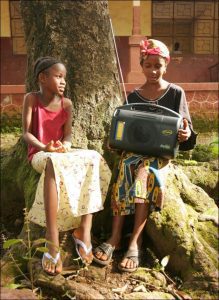 But first, a warning. This solution is not as simple as merely rebroadcasting the series. It will take thought and planning to ensure the programs have a learning impact because effective IAI relies on multiple supporting factors that need to be in place. However with careful and creative thought, it is possible to solve the following fundamental challenges of rebroadcasting legacy programming by making some key decisions must be made before beginning:
But first, a warning. This solution is not as simple as merely rebroadcasting the series. It will take thought and planning to ensure the programs have a learning impact because effective IAI relies on multiple supporting factors that need to be in place. However with careful and creative thought, it is possible to solve the following fundamental challenges of rebroadcasting legacy programming by making some key decisions must be made before beginning:
- Content revision. Is the content relevant to current learning goals and standards? If the answer is generally yes, the next step is to decide how much would need to be updated. If the answer is no, or mostly no, then the IAI series or programs you are considering are probably not useful in the current crisis context.
- Facilitator training. With pupils out of school and guidelines asking people to stay home and practice social distancing, who will facilitate the programs—that is, who will take on the role usually played by a classroom teacher? How will we prepare those people (likely parents, caregivers, or older siblings) to facilitate the IAI lessons? What advice and directions do we give to new facilitators to set themselves and their learners up to best use the programs?
- Supporting materials. Can the programs be used without pre-prepared supporting materials (books, workbooks, teacher guides, etc.)? If the answer is no or mostly no, what materials are absolutely needed to accompany each broadcast? How will they be delivered to the listeners?
- Public awareness. How will listeners’ families and communities learn about the broadcasts, and how can they be motivated to take advantage of them?
Detailed guidance for making each of these decisions is discussed in the following corresponding sections.
Challenge 1: Content Revision
The legacy series you are revitalizing will have been written to deliver the curriculum of its day. It targets certain grades and uses a specific language of instruction. However, curricula may have since been updated, and even the language of instruction may have changed. If the language of the programs is still a language of instruction, it is likely to still be useful, even if a revised or new curriculum has since been put in place. If there are critical—but limited—disparities, hopefully the IAI programs can be quickly edited or changed in the studio. Studio technicians can’t work miracles, but they can employ a few basic tricks to make recording changes to the content, as defined below:
- Selective cutting refers to snipping out content from a program, be it a single word, sentence, segment, or even an entire episode in the series. These changes are quick and easy to make.
- Overdubbing means that instead of cutting out a section of recording, it is altered by a studio technician who splices in a newly recorded change. Thus, additional sentences can be added, or dated terminology can be replaced, with overdubs of short words or phrases. Overdubbing takes more time than cutting. (Note: Overdubbing is made much easier when the original actors are still available, and the unmixed master recordings are accessible. Extensive overdubbing really does require the same voice actors.)
- Rerecording new material involves developing a script for new segments and recruiting actors to record them. Entire sections of new content can be recorded and added to a program. This change takes the most time of all, as new content needs to be developed. Original actors are not necessarily required during rerecording because the recordings of new actors will stand alone as unique segments.
These studio skills can be employed to make changes both to the curriculum content and to the language of broadcast as outlined in Table 1. This table presents a kind of “decision tree” with appropriate steps for using the existing audio program.
TABLE 1. Curriculum changes and solutions
Challenge 2: Facilitator Training
Some IAI series are designed to be broadcast to formal classrooms, others to community schools, and still others to informal listening groups. In each situation, the original program designers operated under a specific set of assumptions and relied on critical characteristics of their listener’s environment. In the current context, it is likely that programs designed for formal classrooms and community schools will be the main targets for repurposing.
These design assumptions need to be identified and accommodated (Table 2). Important questions to ask include the following:
- Are the programs reliant on a trained teacher to guide listeners through activities?
- Is it possible to find and use a substitute facilitator, instead of a trained teacher?
- Can the programs still be used with very small groups of listeners?
If the answer to the latter two questions is yes, it makes sense to offer families and communities simple instructions so that they can set themselves up to get the most benefit from the programs, even if all of the program design assumptions cannot be met. Doing this correctly will require simple and explicit directions to volunteer facilitators (parents, caregivers or older siblings) on setting up a learning space and using the programs.
TABLE 2. Assumptions and solutions
Challenge 3: Print Material Support
If teacher’s guides or student readers and workbooks are a critical part of the program, they must be provided. In most cases, broadcasting the IAI programs and having a facilitator to guide children through the programs are the most critical ingredients and sufficient to use the IAI programs effectively, especially in a crisis context. Providing materials is usually a government-led task, however NGOs and civil society groups can also be pressed into service. Planners should organize to print the requisite books and distribute them as deeply into the listening communities as possible. When door-to-door delivery isn’t feasible, the “last mile” can be crossed by delivering to small local businesses or government offices that remain open and then broadcast directions to families and communities to travel locally and seek them out.
If the delivery networks commonly used by a host country government are problematic or potentially not functioning during the pandemic, look for transport systems in the private sector, such as local busing companies, or approach corporations such as mobile carriers or bottling companies and negotiate a public-private partnership agreement to piggyback on the means they use to disseminate scratch cards and drinks.
If bookbinding costs are high or print-run timelines are long, investigate the possibility of publishing regular low-cost inserts in local newspapers. They have fast daily print runs and established distribution networks. When Internet accessibility and cost are not prohibitive, digitize accompanying workbooks and teacher guides and make them available for download.
When downloading is not possible but receiving texts is free, set up a text-based distribution system. Participants can enroll by texting an advertised number, and then receive a daily text back that prepares them for the upcoming broadcast. They can then transcribe their incoming texts as needed onto their “blackboard” or into learner’s books.
Challenge 4: Public Awareness
A public awareness campaign will be needed to raise awareness of the availability of the radio education programs and to establish new expectations for how parents and communities should support them. Many of the issues addressed in the sections above should be turned into advertising that targets parents. Several public-service and social and behavioral change communications messages will need to be developed and used to saturate the airwaves, both prior to and during the series broadcast. While the program broadcasting may only occur on one national radio station, advertising should be broadcast on as many regional and community radio stations as possible.
Parents do not normally need much convincing to educate their children. In times of crisis, education is usually the first service that parents seek out after they secure food and accommodation. However, many parents have preconceived notions of what education should look like (“Children need a teacher and classroom.”) or who should run it (“It’s the government’s job.”) or what role they are responsible for (“I just pay the fees.”). These notions can arise as obstacles to learning by radio because the paradigm is so different that it can defy comprehension. These preconceived notions should be addressed and corrected by the campaign (“Listen to the Radio … and Learn!”).
Some core messages include the following:
- Although we are in an emergency, children can still learn. They even feel better when they have something familiar to look forward to every day.
- Learning by radio can be just as good as the classroom because the programs are written by very good teachers.
- It is important to make sure you set your child up to listen every day, organize what they need, and protect them from distraction.
- These programs are created and endorsed by the government as a legitimate alternative to school during these times.
- You don’t need to be a teacher to help during the broadcast. The radio will give clear and simple instructions for you to follow. Then your children will learn much more.
- Children learn from songs and games. It might look fun, but it is still serious education.
- You should explain to your neighbors how you are helping your child learn and invite them to do the same with their children.
- Include information for parents and communities on where and how they can access resources to accompany the programs, if these are necessary.
And of course:
- The daily broadcast time for grade 1 is X, for grade 2 is Y, etc.
Conclusion
An IAI series provides a wonderful opportunity for an education system to deliver an interactive learning experience to all children, irrespective of the skills of their teachers or the resources in their schools. It can even be used where there are no teachers or schools. It is designed to run with either low or high levels of support. At the low level of support, unskilled teachers are set up to oversee the learners, to reinforce participation, and to observe the instructional modeling taking place. At the high level of support, skilled teachers work alongside each broadcast to provide instant feedback, encouragement, and the inspired expansion of concepts post-broadcast.
This accommodating design makes IAI a flexible tool for education in emergency situations. Indeed, using a previously developed IAI series to resolve an educational crisis is a great and cost-effective solution, but it will require careful planning and parallel support mechanisms. If the qualitative characteristics and operational assumptions of the legacy series are understood, they can be quickly adapted for maximum utility during the crisis. Necessary changes can be made to its content when educational planners and studio technicians work together systematically. Volunteers— parents, caregivers, older siblings—can step in to play the role of the teacher, and a classroom can be replaced by a home environment. Creative thinking and quick print runs can deliver the needed support materials to learners. And with an innovative training program backed by a vibrant promotional campaign, communities can put the necessary structures in place to maximize the learning of their children.
For more information on these suggested solutions, or for direct help in preparing a series for rebroadcast, contact RChristina[at]edc.org.
_______
Endnotes
1 Final drafts of scripts are notoriously messy and hard to follow. Because they are used by the studio technicians to make last-minute cuts under pressure from broadcast deadlines, they are usually covered in shorthand changes and are substantially different from the final program.
2 IAI training programs have been delivered to teachers via radio with remarkable success in several countries. The methodology is employed to teach the methodology, and the medium quite literally becomes the message.

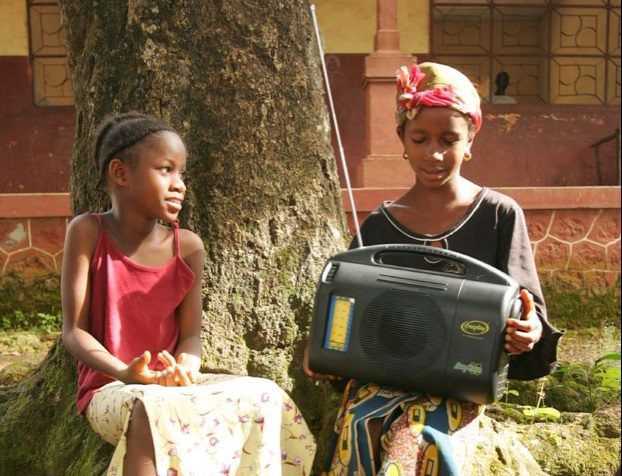
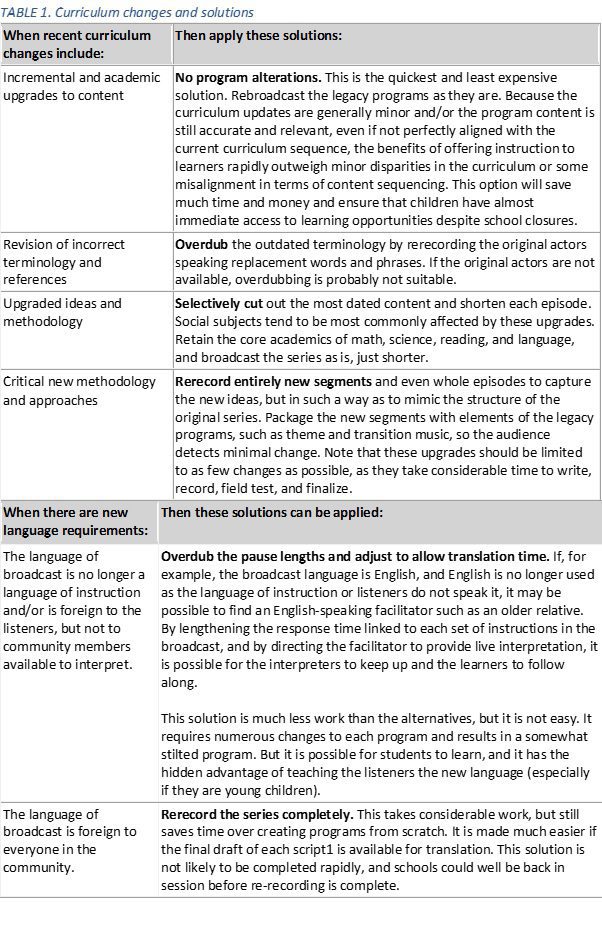
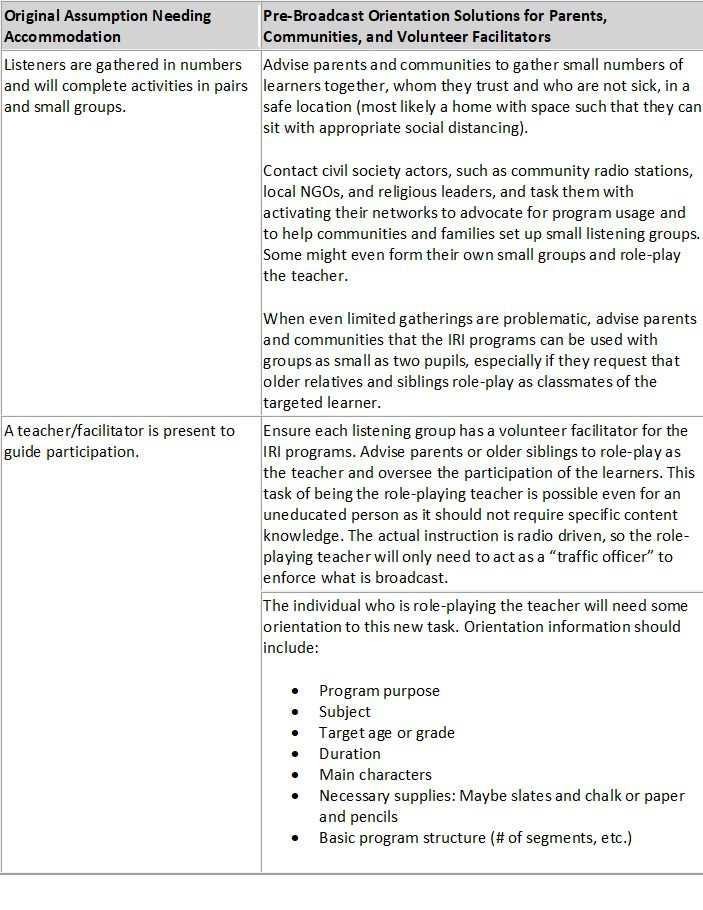
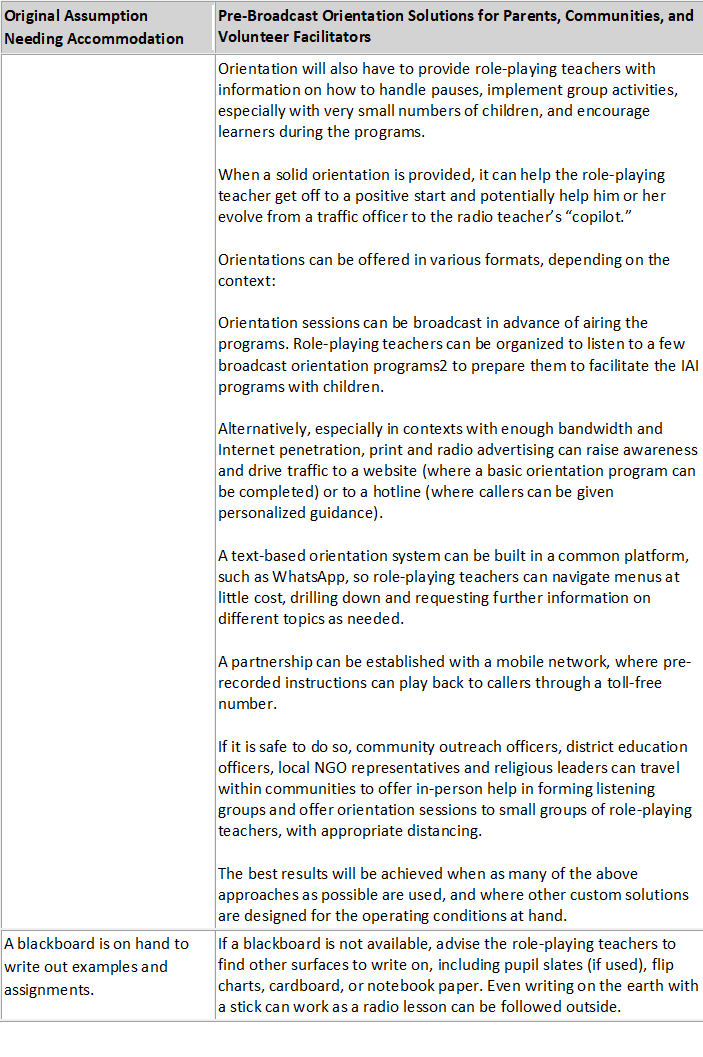
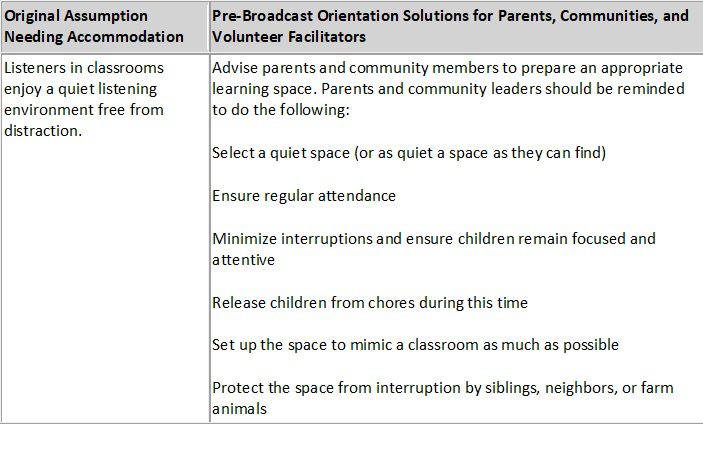



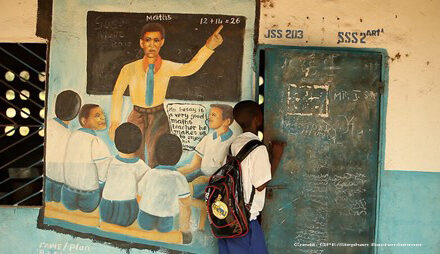
I am not aware of the existence of any interactive audio instruction (IAI) program in Nigeria. Here in the South-South of the country (in the Niger-Delta), it appears that most or all children are without any form of education at this time. Probably a radio program would reach many of the children and their parents. I there any possibility of introducing such programs here?